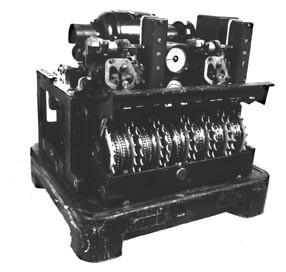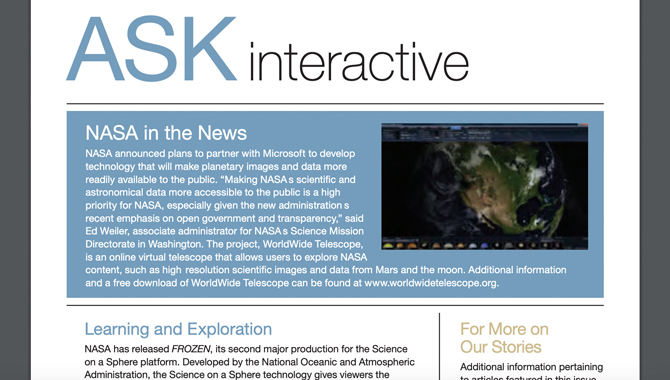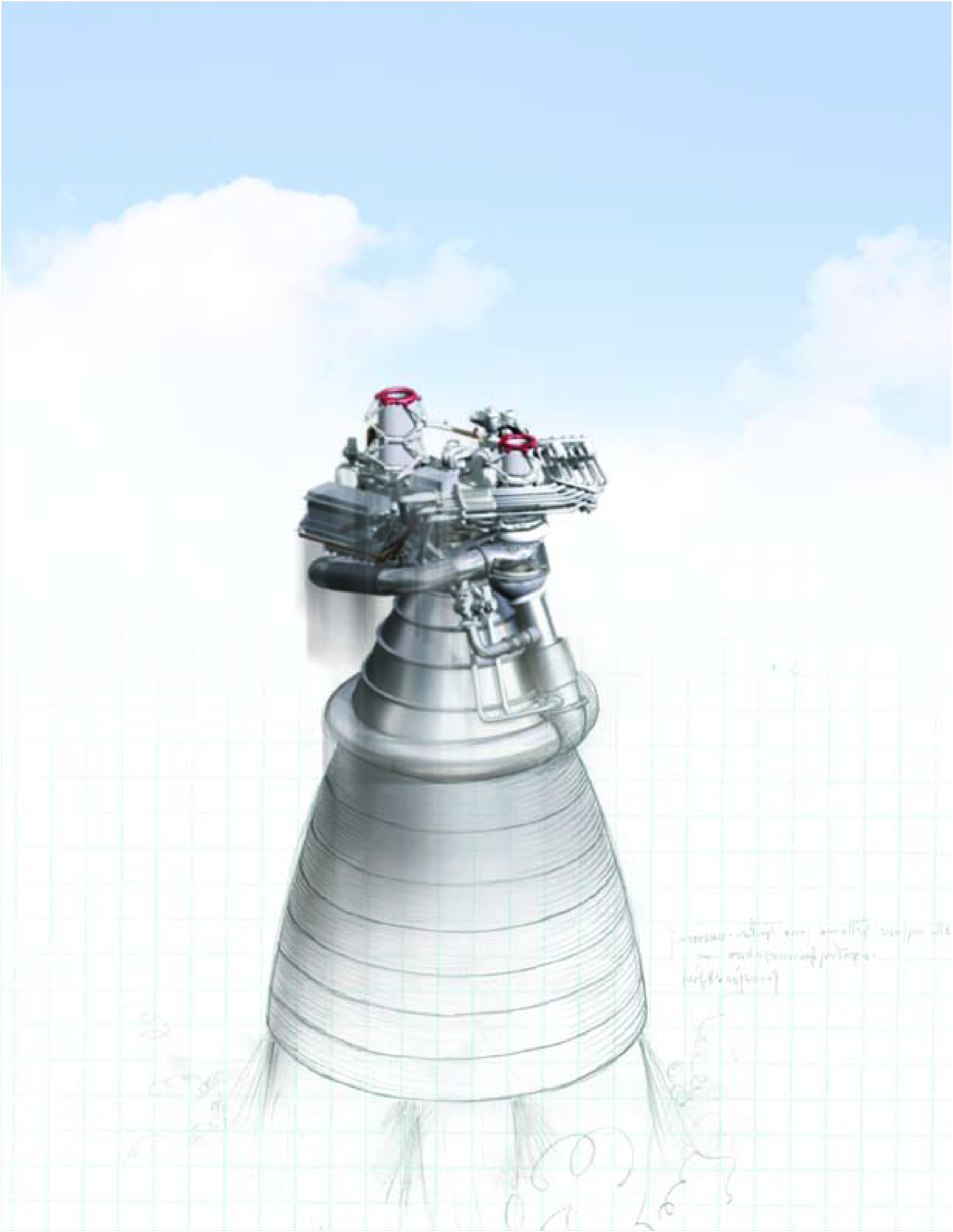
By John Emond
You may wonder what on Earth World War II code has to do with NASA in the twenty-first century. It’s a fair question.

Navajo Indian Code Talkers Henry Bake and George Kirk with a marine signal unit in December 1943.
Photo Credit: National Archives and Records Administration
My response is that the challenges involved in creating communities of special talents to successfully decipher or protect vital information at a time of global conflict provide insight into effective project management practices as NASA addresses its own challenges.
The goals of code makers and code breakers are to protect valuable information on the one hand and to penetrate that shield of protection to uncover vital information on the other. Codes existed long before the current world of software encryption versus computer hackers.
American hero turned traitor Major General Benedict Arnold used a coded message dated July 12, 1780, to tell his British contacts he was to command the fort at West Point, New York, and in that capacity could surrender the fort to the Crown, doing great damage to the American cause. During the American Civil War, both Union and Confederate forces used ciphers.
A World at War
In the spring of 1940, the German blitzkrieg crossed what had been the static battlefields of World War I trench warfare, covering in two months territory they had failed to capture between 1914 and 1918. In Asia, following the December 7, 1941, attack on Pearl Harbor, the Japanese expanded their empire into the Asian continent as well as the Philippines, which surrendered May 6, 1942.
While armies clashed, a battle of minds was fought over vital military information: troop strength, deployment, intended lines of defense, and targets. Codes protected battle plans and strategies; code breakers tried to unlock the keys to such plans.
Code Breakers: Device, Counter-Device
The German Enigma machine was an electromechanical device with rotating “wheels” that scrambled plain text messages into cipher text. When an operator made a keystroke on this typewriter-like device, a given code symbol was sent to the receiving party. Hitting the same keystroke sent a different code symbol; there were billions of potential combinations. To counter this encryption machine, the British at Bletchley Park used a code-breaking device named Bombe, given to them by Polish crypto-analysts at the outbreak of the war.
The Enigma code was broken by 1940. At about that time, the German High Command developed Lorenz, an even more complex coding device. To crack its codes, the British created Colossus, a forerunner to the modern computer that used 1,500 vacuum tubes and read tape at 5,000 characters per second. Cumbersome and unwieldy by today’s standards, it was a major leap forward in data processing at the time. Colossus was delivered to Bletchley Park in June 1943 and was operational in time to confirm that the Germans continued to be deceived regarding the intended site of the D-Day invasion.
Ultimately, though, people, not machines, cracked the German codes. A community arose in Bletchley Park, 50 miles north of London, with the mix of skill and experience required to meet the daunting challenge of German intelligence.
The first group moved there on August 15, 1939, weeks before the start of hostilities. By war’s end, Bletchley Park had grown to an eclectic community of 9,000 people. Among its members were not only brilliant mathematicians (including Alan Turing) and those with traditional science backgrounds, but also a poet, a schoolteacher, a novelist, chess champions, and crossword puzzle experts. (The ability to solve the Daily Telegraph crossword puzzle in under twelve minutes was used as a recruitment test; the winner succeeded in under eight.)
Code Makers: Navajo Code Talkers
While the English were engaged in cracking German military codes, American intelligence officials were trying to devise ways to protect their military communications. Japanese code breakers, some of whom had lived in the United States and were fluent in American English—even American slang— intercepted or sabotaged communications sent to and from units in the field. In 1942, Philip Johnston read a newspaper account of the Louisiana code military communications staff trying to use Native American personnel for code development. That inspired Johnston, the son of a Protestant missionary who grew up with Navajo children, to raise the idea of Navajo “code talkers” in a briefing to Lt. Colonel James Jones.
Until just prior to World War II, the Navajo language had never been written or translated. A new dictionary was devised to convert military terms into Navajo words, often with an origin in Navajo culture, which raised the complexity of the message and increased the difficulty of uncovering its true meaning. For instance, the Navajo word “lo-tso,” meaning “whale,” was used for “battleship;” “chay-da-gahi” (tortoise) was “tank;” and “da-he-tih-hi” (hummingbird) was “fighter plane.”
American Indians were trained to encode, transmit, and decode a three-line English message in twenty seconds; machine translation took thirty minutes. Though many code talkers had never been away from their reservation, all but two who were left behind to train others were deployed to Guadalcanal in U.S. Marine units. There was little time to test this code system before it was deployed under combat conditions. In addition to the Guadalcanal campaign, Navajo code talkers took part in every Pacific combat operation from 1942 to 1945, including Saipan, Iwo Jima, and Okinawa. By war’s end there were 450 Navajo code talkers.
High Risk, High Rewards
Project managers at Bletchley Park and those who supervised the Navajo code talkers engaged in high-risk, high-reward situations. The English could have failed to crack the German codes, or German intelligence could have discovered that their codes were compromised. Either eventuality could have greatly increased casualties and possibly changed the war’s outcome.
Success in breaking the German code produced dramatic benefits. The Royal Air Force (RAF) had advance knowledge of the German air force’s (Luftwaffe) overall strategy regarding English targets during the 1940 Battle of Britain. The heroic defense of the RAF, and the strategic error of the Luftwaffe in shifting from air attacks on RAF bases to bombing London and other cities, meant English victory in the air war. Without air supremacy, the Germans could not invade England. Knowing the German codes and communication messages meant Allied naval forces could interdict the German U-boat “wolf packs” that had preyed on Allied merchant shipping in the Atlantic, particularly U.S. supply convoys that kept England alive.
Deciphering the German codes also enabled Allied forces to attack German Afrika Korps ship convoys, denying crucial supplies to General Erwin Rommel’s desert army and helping to weaken his army’s offensive and defensive operations. Perhaps the most dramatic success was the verification at Bletchley Park that the Germans remained deceived about the D-Day invasion site. If the Germans had known in advance the “spear tip” of the invasion target was to be Normandy, plans could have been put in motion to make the Allies pay a much steeper price.
As for the Navajo code talkers, failure to protect the code would have exposed many thousands of U.S. Marines in their Pacific island–hopping campaigns to even greater danger than they actually faced. The full impact of the code talkers may never be known. According to Major Howard Connor, Fifth Marine Division signal officer, were it not for the Navajos, the Marines would never have taken Iwo Jima. Six Navajo code talkers worked around the clock during the first forty-eight hours of battle on Iwo Jima; 800 messages were sent without error.
Given the damage that would have resulted if the enemy had learned the secrets of Bletchley Park and the Navajo code talkers, project management placed a great deal of trust in these communities. That trust proved to be well-founded. The secrets of these operations went undisclosed for decades after the war’s end.
Meeting NASA’s Challenges
NASA does not face such wartime crises, but the Agency has encountered and met many challenges and faces many more in its evolution from “sortie” missions in low-Earth orbit to a crewed International Space Station and long-duration exploration missions. Some of the big ones include the following:
- In life sciences, adaptation to variable gravity environments, radiation mitigation, telemedicine/remote medical diagnosis and treatment, sustainable sources of food and water, and psychological and physical stress factors of long durations in closed environment systems at great distances from the Earth
- Advance material development for habitat construction and performance in extreme environments
- Energy conservation and production
- New technologies in spacecraft propulsion
- In-situ resource utilization
Successfully meeting these and other challenges will require many minds from many disciplines to share ideas and generate a varied range of approaches to common goals and objectives. As in the cases of Bletchley Park and the Navajo code talkers, NASA will need to seek out and welcome new expertise, some of it from untraditional and unexpected sources.
This process has already begun. In recent years, the Agency has begun to explore new approaches and creative, nontraditional paths to technology advancement. Today, NASA missions involving modeling and simulation draw on men and women who grew up on computer simulation games, much as Bletchley project management used crossword puzzle experts to explore cipher code formation. NASA’s Centennial Challenge looks for expertise wherever it exists by using prize money to encourage individuals or teams outside NASA to meet specific technology objectives. In 2007 the Astronaut Glove Challenge to improve glove design was won by Peter Homer, a former aerospace engineer whose background included—in addition to aerospace—sailing and sail making. Working at his dining room table, Homer crafted an improved glove design that included off-the-shelf materials.
One might argue that the English code breaker and American code maker project managers took major risks in their nontraditional approaches and personnel. They did so because the stakes were so high that new approaches, even apparently risky ones, were justified by the need to confront the deadly challenges faced. NASA’s future missions will not be part of dire combat for survival, and NASA’s mandate is to broadly disseminate, not hide, its goals and its knowledge. But the magnitude and difficulty of NASA’s future missions, and the challenges known and still to be encountered, require the same level of commitment, determination, and trust. Only by broadly using and trusting the creative, dedicated talents of a wide and diverse community will we succeed.
Note: Special thanks to The Bletchley Park Trust (www.bletchleypark.org.uk) for their cooperation.












